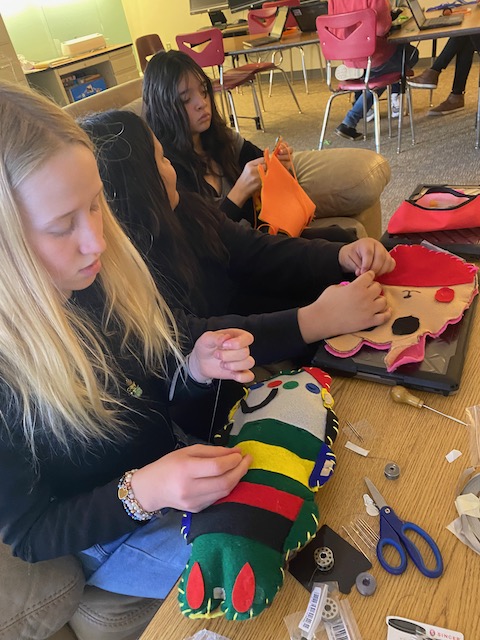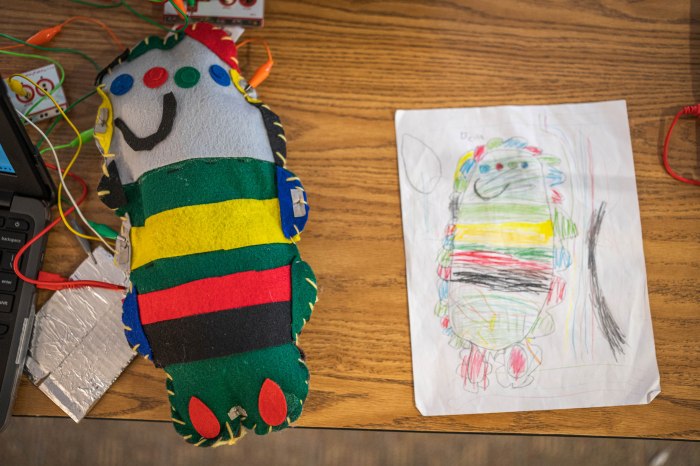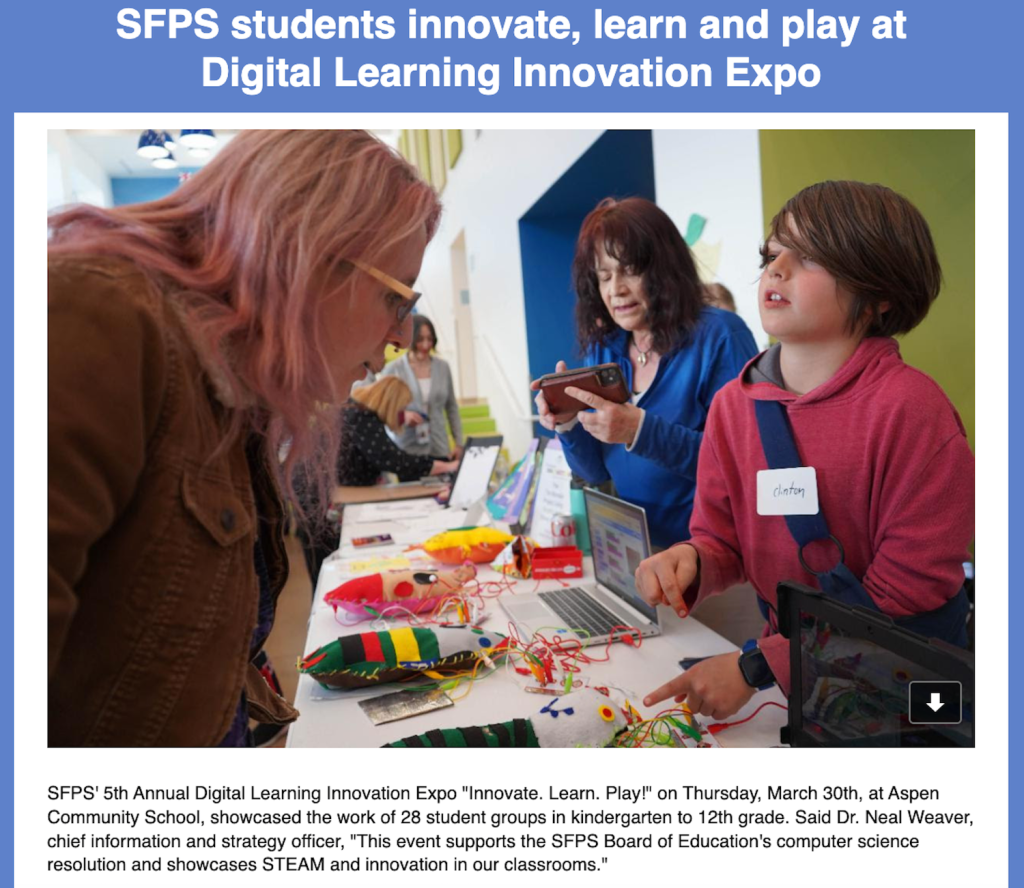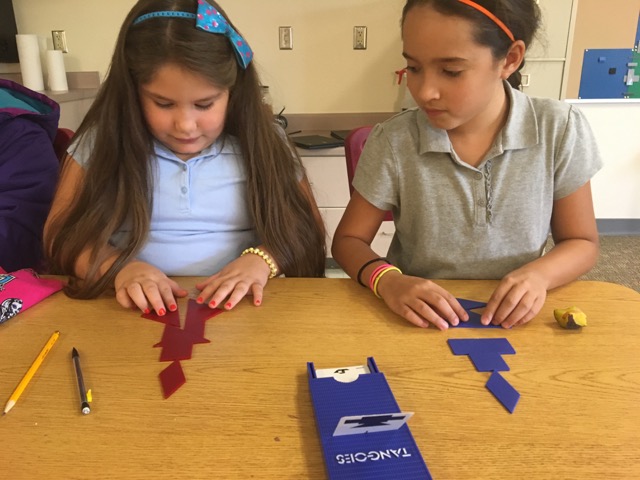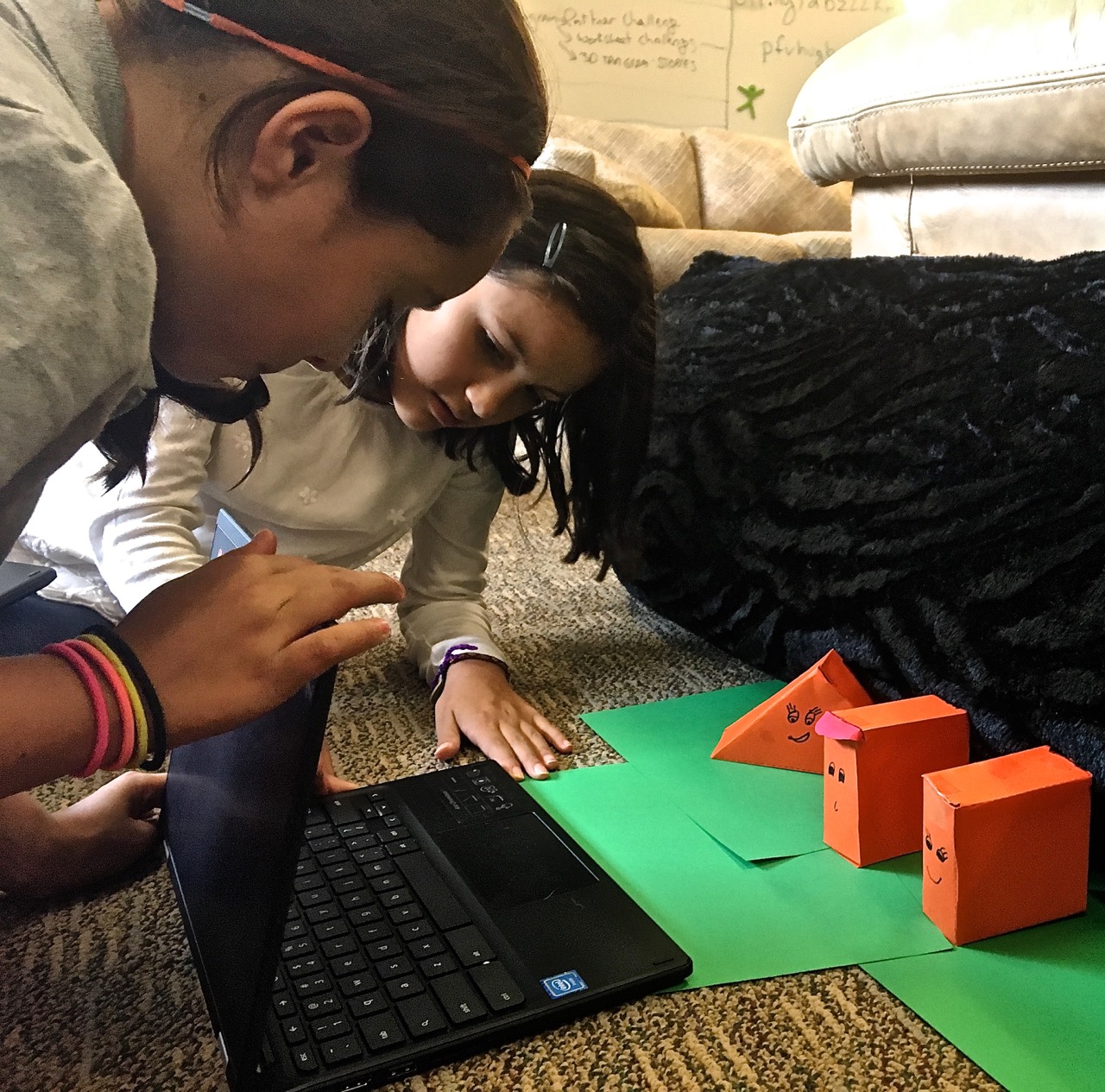Posts Tagged ‘interdisciplinary learning’
Monster Project Using Makey Makeys and Scratch
This project takes the Monster Project enhancing it with interactivity created through using Scratch and Makey Makeys. It was inspired by the Makey Makey Hack a Toy Lesson. Part of the lesson included the 5th graders interviewing 1st graders. This Edutopia article discussed the benefits of interviewing – Learning to Interview Builds a Range of Communication Skills.
Making the Monsters
A 1st grade teacher was asked to have her student draw monsters.

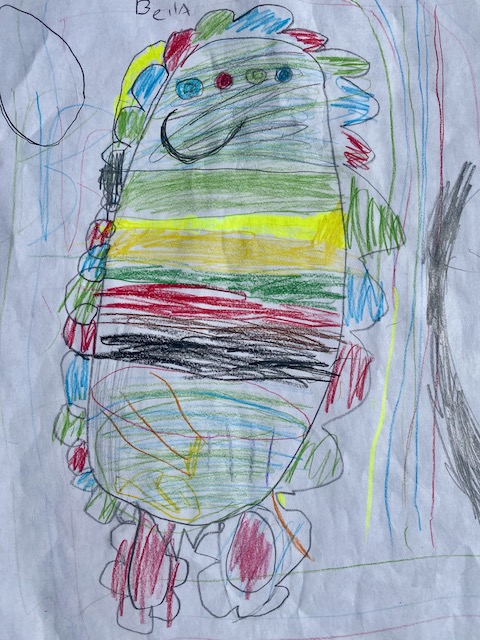
The 5th graders used felt to recreate the 1st graders’ drawing using felt. They were then sewn together with yarn and stuffed with filling.
Preparing the Plushy
The SAGE students created larger versions of the 1st graders’ drawn monsters through using felt pieces for the base and the features of the drawing, adding a back, sewing it today with yarn, and stuffing it
Interviewing the 1st Graders
The interview questions were developed by the SAGE students first by brainstorming ideas on the Promethean board, and second sharing them on a Google Doc so they each had a copy:
Interviews
The SAGE 5th graders interviewed the 1st graders about their Monsters using Vocaroo. It produces a MP3 file which is compatible with Scratch. This file is downloaded.
Preparing the Files in Scratch
The SAGE students then uploads their MP3 files into Scratch where it is edited into clips of sounds. This link gives some details how to do so https://helpkidscreate.com/adding-audio-to-scratch/.


See more of their code:
- Elizabeth – https://scratch.mit.edu/projects/793092586
- Tao – https://scratch.mit.edu/projects/811334666/
- Emily – https://scratch.mit.edu/projects/827406003
- Valerie – https://scratch.mit.edu/projects/796614386
- Emily (Spanish Version) – https://scratch.mit.edu/projects/830970807
After the 5th graders made the plushies, they prepared them to be connected to the Makey Makey by taping in conductive tape and sewing in conductive thread as described in https://makeymakey.com/blogs/how-to-instructions/maker-class-lesson-two-hack-a-toy


The Reveal to the 1st Graders
When all of the projects were complete, they were set up in our classroom and the 1st graders were brought in for the reveal.
Presenting Their Projects at Our Innovation Fair
Several SAGE students presented their Monster Projects at our district’s innovation fair.
Extra – Animated Drawings and Blabberize
As an extra project and to enable younger students to get more involved with the technology, the older students can help them animated their drawings using https://sketch.metademolab.com/:
which can then be uploaded to Canva to create a party of multiple monsters:
To learn how to do this, see the @theMerrillsEDU tutorial at https://youtu.be/JTukQCTj2fo?si=kdsM0vTyekRLFaRY
or Blabberize their monsters.
- http://blabberize.com/view/id/2165233
- http://blabberize.com/view/id/2165238?secret=f97ef182
- http://blabberize.com/view/id/2165250
- http://blabberize.com/view/id/2165249
- http://blabberize.com/view/id/2159218
Standards Addressed
CCSS – English Language Arts
- Interpret information presented in diverse media and formats (e.g., visually, quantitatively, orally) and explain how it contributes to a topic, text, or issue under study.
National Core Arts Standards
- Students will generate and conceptualize artistic ideas and work.
CSTA Standards
- Decompose (break down) problems into smaller, manageable subproblems to facilitate the program development process.
- Modify, remix, or incorporate portions of an existing program into one’s own work, to develop something new or add more advanced features.
ISTE Standards for Students
- Students create original works or responsibly repurpose or remix digital resources into new creations.
- Students publish or present content that customizes the message and medium for their intended audiences.
NAGC (National Association for Gifted Children) Standards
- Standard 1: Gifted individuals demonstrate skills, abilities, and potential commensurate with high performance.
- The project demonstrates the students’ advanced skills in creativity, problem-solving, and technical proficiency in programming and electronics.
- Standard 2: Gifted individuals demonstrate task commitment and perseverance to high-level work.
- The project showcases the students’ commitment and perseverance as they went through multiple stages, from creating stuffed animals to conducting interviews, programming, and connecting the Makey Makeys.
- Standard 3: Gifted individuals demonstrate creativity and risk-taking.
- The project involves the students’ creative thinking and risk-taking as they transformed the monster drawings into physical stuffed animals and integrated technology to make the interviews interactive.
- Standard 4: Gifted individuals demonstrate the ability to work both independently and within groups.
- The project required the students to collaborate within their group to complete different aspects, such as designing the stuffed animals, conducting interviews, programming in Scratch, and connecting the Makey Makeys.
- Standard 5: Gifted individuals demonstrate effective communication skills.
- The students exercised their communication skills during the interviews with the 1st graders and also used technology to convey their messages through the Scratch programming language and the Makey Makey connections.
- Standard 8: Gifted individuals demonstrate sensitivity to their own and others’ well-being.
- The project fostered empathy and awareness as the older students interacted with the 1st graders and translated their drawings into tangible stuffed animals, providing a sense of validation and pride for the younger children
Cross-Curricular Lesson: Communicating with Parents
As someone who has been in teacher education for several decades, I often think about – teach about how to make curriculum engaging, fun, effective, authentic, and relevant for learners. I believe interdisciplinary or cross-curricular lessons have the potential to do so. I also add, when I am working with pre- and inservice teachers, that there is not enough time in a day to teach-learn everything that is desirable. Cross-curricular activities can help “create” more time as several content area standards can be addressed in one lesson.
Multidisciplinary or interdisciplinary learning is a “whole” or “comprehensive” method that covers an idea, topic, or text by integrating multiple knowledge domains. It is a very powerful method of teaching that crosses the boundaries of a discipline or curriculum in order to enhance the scope and depth of learning. Each discipline sheds light on the topic like the facets of a gem.
I created the following graphic to show the benefits of interdisciplinary standards.
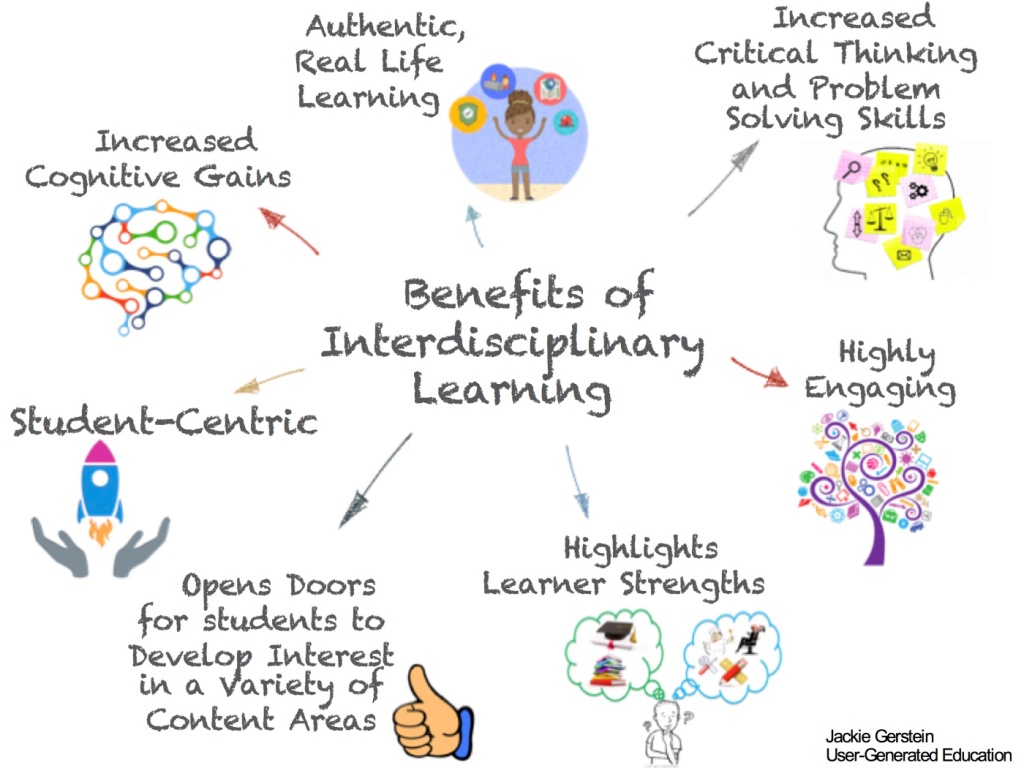
An Example: Communicating with Parents
This past week I asked my freshman seminar class to do a few activities related to communicating with their parents. The goal of this lesson was, obviously, to have to students develop some more effective communication strategies.
Social Emotional Learning and 21st Century Standards
This lesson, at its core, falls into the areas socio-emotional learning and 21st Century Competencies. Ohio established their own set of K-12 Social and Emotional Learning Standards and the following are related to the goals of this lesson.
- Actively engage in positive interactions to make connections with peers, adults and community to support and achieve common goals,
- Establish and actively participate in a healthy network of personal, school and community relationships.
The Framework for 21st Century also identified communication as an important skill with the following standards.
- Articulate thoughts and ideas effectively using oral, written and nonverbal communication skills in a variety of forms and contexts,
- Listen effectively to decipher meaning, including knowledge, values, attitudes and intentions.
English Language Arts Standards
Because the learners were asked to do research and write a letter to their parents, English Language Arts standards were also addressed:
CCSS.ELA-LITERACY.W.9-10.7
Conduct short as well as more sustained research projects to answer a question (including a self-generated question) or solve a problem; narrow or broaden the inquiry when appropriate; synthesize multiple sources on the subject, demonstrating understanding of the subject under investigation.
CCSS.ELA-LITERACY.W.9-10.2
Write informative/explanatory texts to examine and convey complex ideas, concepts, and information clearly and accurately through the effective selection, organization, and analysis of content.
Communicating with Parents Poster
Learners were asked to review some online articles about communicating with parents and then make a poster that reflected strategies they believe to be important.
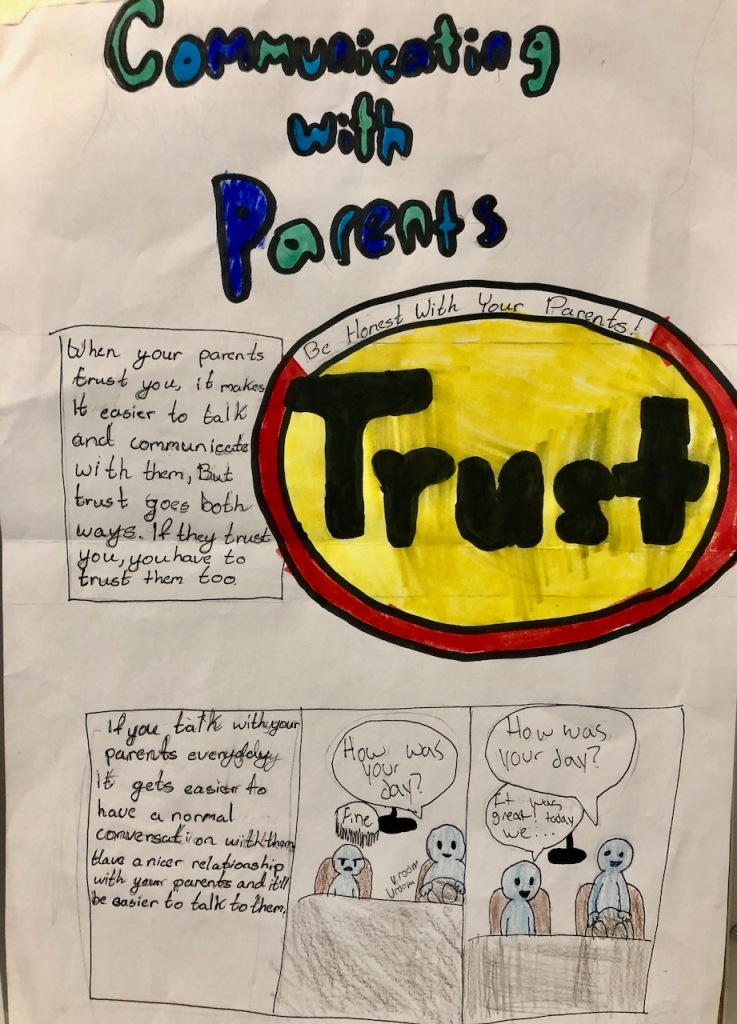
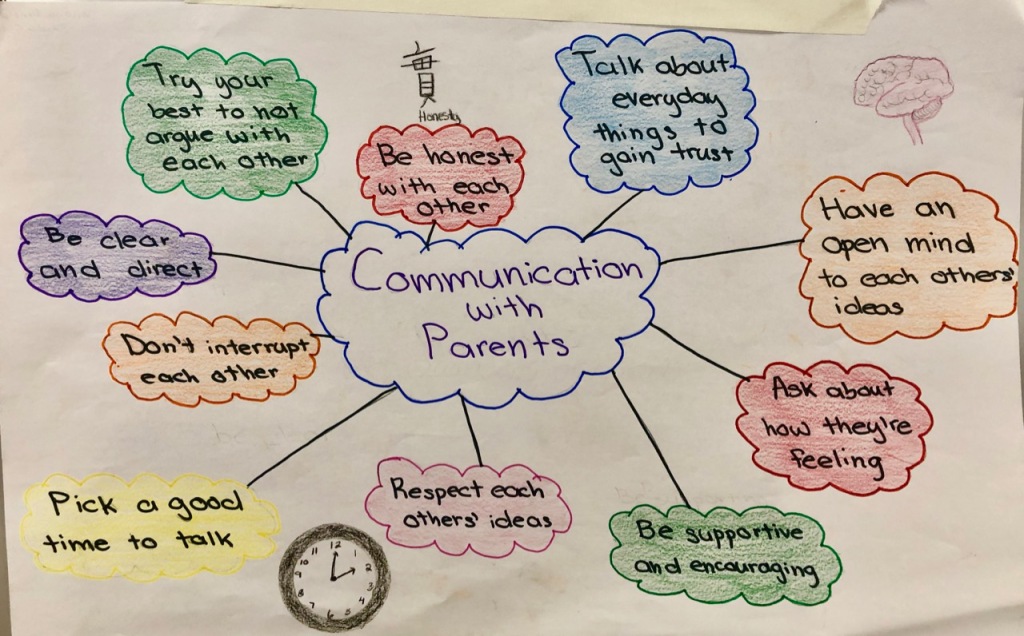
Letter to My Parents
Next, the learners were asked to write a letter to their parents that discussed:
- What types of communications are going well,
- What types of communications are not going well,
- Suggested goals for improving communications.
They were told they were not required to share the letter with their parents. Some examples follow:
All Lessons Should Be Interdisciplinary
I am not a fan of worksheets. In fact, I hate most of them. They don’t teach real world skills. How often does someone do worksheets outside of school? How often when they become adults? They also tend to focus on a single content area concept like specific math problems or questions about a particular text.
I used to teach face-to-face elementary education classes to pre-service teachers. There is evidence that teachers teach the way they were taught. I know that almost everyone has been subjected to worksheets as part of their K-12 (even college) education. It follows, then, that theses new teachers will use worksheets as part of their teaching strategies. I can’t blame them especially if they are not intentionally taught and do not practice other instructional strategies as part of their education.
My instruction with them included a focus on interdisciplinary/cross-curricular, thematic, experiential, and project-based learning. I did very little sage on the stage with them during our classes as I wanted them to directly experience these strategies. They did lots of group discussion, case study analysis, and hands-on activities. I often said to them, “You really don’t have enough time in a day to adequately address all of the individual content areas. It is in both your and your students interest to layer your curriculum with a variety of content area concepts, ideas, and skills that can only occur with more project-based and interdisciplinary lessons. Worksheets won’t do this.”
Multidisciplinary or interdisciplinary learning is a “whole” or “comprehensive” method that covers an idea, topic, or text by integrating multiple knowledge domains. It is a very powerful method of teaching that crosses the boundaries of a discipline or curriculum in order to enhance the scope and depth of learning. Each discipline sheds light on the topic like the facets of a gem.
Imagine being able to teach character development, basic math, and basic science concepts via a classic text. How about basic geography, writing skills, and point of view from that same text? Is it possible to also teach about comprehension, sequence, literal vs. non-literal, imagination, plot, theme, compare and contrast, opinion pieces, vocabulary, friendship, bullying, and critical thinking? The answer is yes, and the genre is legends, myths, and fables (https://www.edutopia.org/blog/a-cornucopia-of-multidisciplinary-teaching-vincent-mastro).
Benefits of Interdisciplinary Learning:
- Obviously, it addresses multiple content areas resulting in increased cognitive development as deeper learning occurs.
- It mimics real life learning rather than isolated educational experiences. It is authentic. When we learn something in the real world, it is interdisciplinary. For example, when learning how to bake or cook something new, one often does research for the best recipes and cooking strategies, reading of recipes and directions, and using math in the actual cooking or baking.
- It helps students increase their critical thinking and problem solving skills. Due to the nature of interdisciplinary learning which often includes the characteristics of deep and project-based learning, students are asked to make their own connections and conclusions about their learning.
- It is student-centric. The focus is on the student rather than on the teacher and on lower levels of Bloom’s taxonomy that often occurs when students are given drill and grill learning activities.
- It tends to be highly engaging for students. They engage because interdisciplinary activities often have at least one content area that is of great interest to the student. It highlights their strengths.
- It opens doors for students to develop interest in content areas in which they have not been typically interested as they see connections between their desirable content areas and other ones.

Some of my blog posts about my interdisciplinary lessons:
- Gingerbread House Making: A Fun and Engaging Cross-Curricular Lesson https://usergeneratededucation.wordpress.com/2018/12/08/gingerbread-house-a-fun-and-engaging-cross-curricular-lesson/
- Day of the Dead (Dia de los Muertos) Displays: A Maker Education Project https://usergeneratededucation.wordpress.com/2018/11/06/day-of-the-dead-dia-de-los-muertos-displays-a-maker-education-project/
- Robot-Enhanced Creative Writing and Storytelling (featuring Ozobot and Wonder’s Dot) https://usergeneratededucation.wordpress.com/2018/05/15/robot-enhanced-creative-writing-and-storytelling-featuring-ozobot-and-wonders-dot/
- Elementary Social Entrepreneurship: A Perfect STEAM Lesson https://usergeneratededucation.wordpress.com/2018/05/13/elementary-social-entrepreneurship-a-perfect-steam-lesson/



